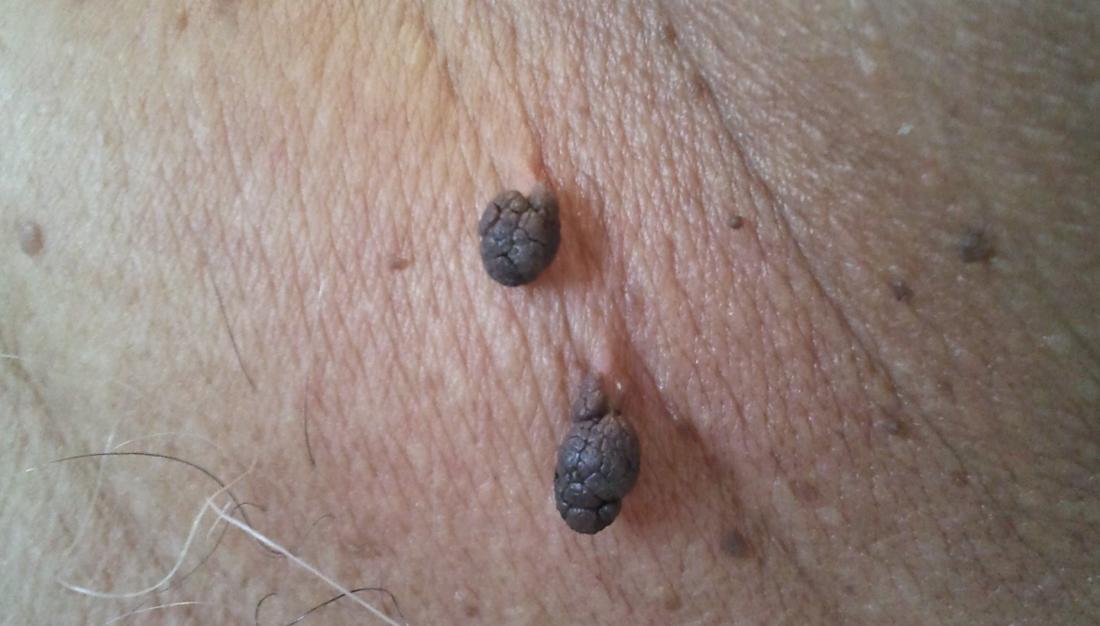A skin tag is a small piece of soft, hanging skin that may have a peduncle, or stalk. They can appear anywhere on the body, but especially where skin rubs against other skin or clothing.
Other names are an acrochordon, cutaneous papilloma, cutaneous tag, fibroepithelial polyp, fibroma molluscum, fibroma pendulum, soft fibroma, and Templeton skin tags.
Skin tags are very common and generally occur after midlife. They affect men and women equally.
- Skin tags are benign tumors of the skin.
- They commonly occur in creases or folds of the skin.
- They are not dangerous, but they can be removed for aesthetic and cosmetic reasons.
- Methods of skin tag removal include over the counter (OTC) therapies, excision, and cryotherapy.
What are skin tags?

Skin tags are harmless and often removed for cosmetic reasons.
Grook Da Oger, own work, 2012
Skin tags are benign, noncancerous, tumors of the skin. They consist of a core of fibers and ducts, nerve cells, fat cells, and a covering or epidermis.
They may appear on the:
- eyelids
- armpits
- under the breasts
- groin
- upper chest
- neck, in the case of papilloma colli
They often go unnoticed, unless they are in a prominent place or are repeatedly rubbed or scratched, for example, by clothing, jewelry, or when shaving.
Some people may have skin tags and never notice them. In some cases, they rub off or fall off painlessly. Very large skin*tags may burst under pressure.
The surface of skin tags may be smooth or irregular in appearance. They are often raised from the surface of the skin on fleshy peduncles, or stalks. They are usually flesh-colored or slightly brownish.
Skin*tags start small, flattened like a pinhead bump. Some stay small, and some grow bigger. They can range in diameter from 2 millimeters (mm) to 1 centimeter (cm), and some may reach 5cm.
Treatment
As skin tags are usually harmless, removal is normally for aesthetic or cosmetic reasons.
Large skin tags, especially in areas where they may rub against something, such as clothing, jewelry or skin, may be removed due to irritation.
Removing a large skin tag from the face or under the arms can make shaving easier.
Surgery
The following procedures may be used:
- Cauterization: The skin tag is burned off using electrolysis
- Cryosurgery: The skin*tag is frozen off using a probe containing liquid nitrogen
- Ligation: The blood supply to the skin*tag is interrupted
- Excision: The tag is cut out with a scalpel
These procedures should only be done by a dermatologist, or specialist skin doctor, or a similarly trained medical professional.
Skin*tags on the eyelid, especially those close to the eyelid margin, may have to be removed by an ophthalmologist, or specialist eye doctor.
Removing a skin tag at home is not normally recommended, due to a risk of bleeding and possible infection.
However, very small tags can be removed by tying dental floss or thin cotton thread around the base of the tag to cut off circulation to the tag.
Over-the-counter solutions
Over-the-counter (OTC) solutions are available at pharmacies. These freeze the skin*tag, and it will fall off after 7 to 10 days. These may also be purchased online, although it is recommended that professional medical advice is sought before using these treatments.
These medications are similar to those used for wart removal.
There is no evidence that removing skin*tags encourages more of them to develop.
Causes
It is not clear exactly what causes skin tags, but it may happen when clusters of collagen and blood vessels become trapped inside thicker pieces of skin.
As they are more common in skin creases or folds, they may be mainly caused by skin rubbing against skin.
Some people appear to inherit an increased susceptibility to skin tags.
Skin*tags affect people both males and females, but they happen more often during pregnancy, in people who are obese, and in people with diabetes.
They have been associated with hyperinsulinemia, when there is too much insulin circulating in the blood.
Risk factors for skin tags
Skin tags appear to be more common in:
- people who are overweight and obese
- those with diabetes
- women during pregnancy, possibly due to hormonal changes and high levels of growth factors
- those with some types of human papilloma virus (HPV)
- people with a sex-steroid imbalance, especially if there are changes in levels of estrogen and progesterone
- those whose close family members also have skin tags
Studies have found that skin*tags are more likely to occur with:
- obesity
- dyslipidemia, for example, high cholesterol levels
- hypertension, or high blood pressure
They have also been linked to insulin resistance and elevated high-sensitive C-reactive protein, a marker of inflammation.
This suggests that skin tags may offer an external sign of an increased risk of insulin resistance, metabolic syndrome, atherosclerosis and cardiovascular disease.
More rarely, skin*tags are rarely associated with:
- Birt-Hogg-Dubé syndrome
- Polycystic ovary syndrome
Birt-Hogg-Dubé (BHD) syndrome is a rare genetic condition characterized by skin tumors, including multiple fibrofolliculomas, trichodiscomas, and acrochordon, or skin*tags. Carcinomas, or cancerous tumors, may also develop in the kidneys and colon.